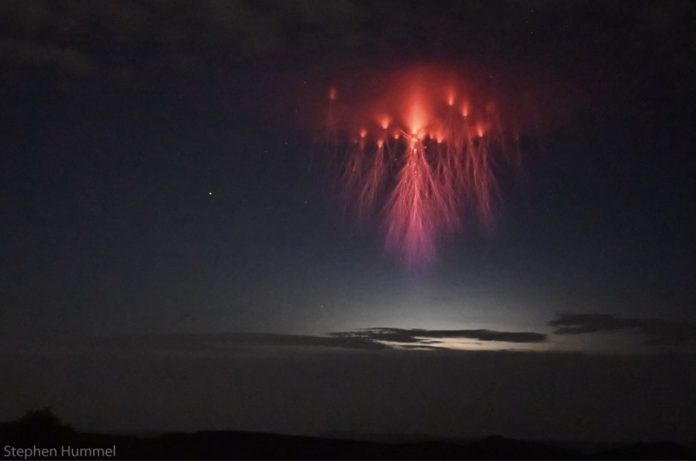Did you know that lightning sprites – like the one captured in the image above – exist above some thunderstorms? Sprites aren’t terribly well known, except to meteorologists, nature photographers and others who study the skies. They aren’t especially rare, but they’re fleeting. They’re not easy to capture on film. Lightning sprites are electrical discharges high in Earth’s atmosphere. They’re associated with thunderstorms, but they’re not born in the same clouds that send us rain. Thunderstorms – in fact all earthly weather – happen in the layer of Earth’s atmosphere called the troposphere, which extends from Earth’s surface to about 4 to 12 miles (about 6 to 19 km) up. Lightning sprites – also known as red sprites – happen in Earth’s mesosphere, up to 50 miles (80 km) high in the sky.
So when you’re standing on Earth’s surface and you spot one, it appears relatively small, even though, in fact, sprites can be some 30 miles (50 km) across. As Matthew Cappucci of the Washington Post’s Capital Weather Gang said in an article about lightning sprites last year:
Imagine one electrical discharge spanning the distance from Baltimore to Washington, D.C.
Cappucci also commented:
Although sprites are poorly understood, atmospheric electrodynamicists have figured out the basics behind their formation. Sprites are often triggered by a strong, positive bolt of ordinary lightning near the ground. They’re thought to be a balancing mechanism that the atmosphere uses to dispense charges vertically. It’s a quick process that takes less than a tenth of a second.
That’s what makes hunting for sprites so tough. Blink and you’ll miss them.
The fleeting aspect of lightning sprites probably explains why – when people first see photos of them – they’re surprised that such a strange-looking weather phenomenon even exists.
Also, it hasn’t been that many years since lightning sprites were confirmed. In the 20th century, pilots spoke of “flashes above thunderstorms.” Lightning sprites as we know them today weren’t captured and their intricate structure didn’t begin to be recorded on film until as late as 1989, when experimental physicist John R. Winckler (1916-2001) happened to capture one while testing a low-light television camera.





























